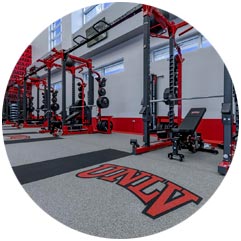Commercial Gym Flooring Buyers Guide
Rubber Flooring • Turf
Reach out to our flooring experts or fill out a form for a quick quote. We're here to help with product selection, design & layout, quoting, and maintenance. Whether it’s a brand new build-out or an upgrade to an existing space, we have the flooring solution for your facility.
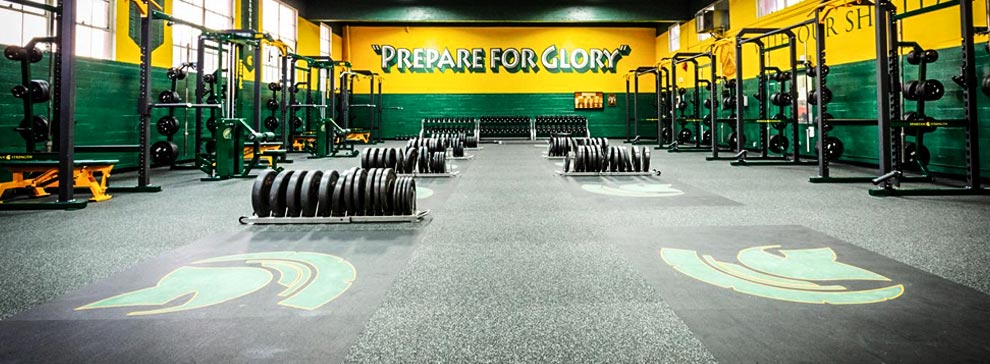
Ecore Rubber Flooring
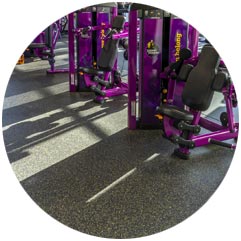
Basic Fit Rolled Rubber
KNOW MORE
Provides wall-to-wall flooring for seamless movement & aesthetics.
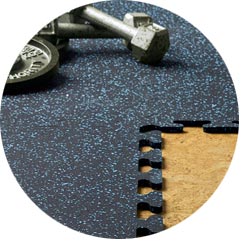
Basic Fit Puzzle Tiles
KNOW MORE
Puzzle Tiles are interlocking rubber floor tiles which are durable and economical.

Performance UltraTile
KNOW MORE
Super-durable rubber floor tiles that set the standard for noise & shock absorption.

RageTurf Motivate
RageTurf Motivate features a dense, textured polyethylene surface layer, making it ideal for footwork drills and sled work.
KNOW MORE
Everything you need to know about buying commercial gym flooring
We’ve heard time and time again that selecting the correct rubber flooring for a fitness center or gym can quickly become overwhelming. Some common questions we receive are, “Where do I start? What’s the difference between interlocking tiles and rolled rubber? What floor thickness should I be looking at?” We’ve compiled some FAQs below..
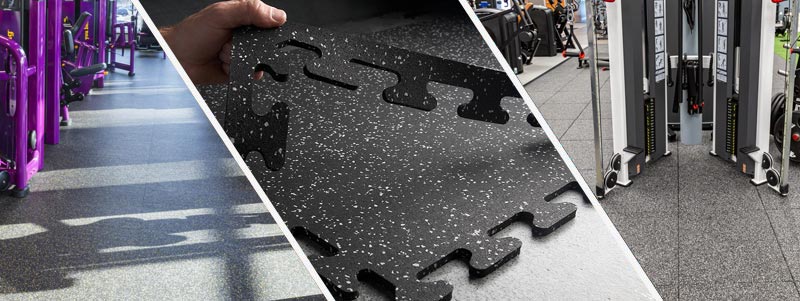
L-R: Ecore Basic Fit Rolled Rubber, Basic Fit Interlocking Tiles, Performance UltraTile
What are the different types of rubber flooring?
As you begin researching your purchase, consider four types of rubber flooring offered.
-
Basic Fit Rolled Rubber: Rolled Rubber Flooring provides wall-to-wall solution for seamless movement & aesthetics.
-
Basic Fit Interlocking Tiles: Tiles are interlocking, durable and economical; available in corner, center, & border pieces.
-
Performance UltraTile: Tiles offer excellent sound dampening and shock absorption for all fitness surfaces.
-
Performance Monster: Recycled rubber is molded together for added comfort and minimal shock impact.
What’s the difference between each type of rubber flooring?

Rolled Rubber Flooring offers seamless coverage for your whole facility.
Basic Fit Rolled Rubber Flooring
Basic Fit Rolled Rubber Flooring provides a wall-to-wall solution for seamless movement & aesthetics. This product is known for its sleek looks and extreme durability. When correctly installed, you’re unable to see where one roll ends and the next begins. You’ll find rolled rubber flooring for gyms as a staple in the majority of traditional facilities.
Benefits of Rolled Rubber Flooring
- DIY friendly
- Ultra-durable
- Made with reclaimed rubber materials
- 100% recycled rubber
- Nearly maintenance-free
- 5-Year warranty
Rolled Rubber Flooring Maintenance
Basit Fit rolled rubber flooring is easy to clean, and easy to maintain with the right products and protocol. We recommend putting a cleaning schedule in place for staff to follow, including both daily and weekly cleaning. Always use a cleaner intended for use on rubber sport flooring, and don’t settle for any generic cleaner. The right rubber floor cleaner can not only keep your facility fresh, but also maintain your flooring and protect it from unwanted wear patterns and damage. To help facilities get the right rubber floor cleaning process in place, we put together a handy maintenance guide.
Installation
When it comes to installation, the rolls are heavy, but with a team of two or more, rolled rubber flooring is easy to install. You’ll want to check your subfloor to make sure they meet installation requirements, but don’t worry, our installation guide covers all that. We’ll get into more detail about installing rolled rubber flooring in a bit.
Durability & Impact Resistance
Because rolled rubber flooring is sound and shock-resistant, you’ll be preserving your members’ joints AND their ears (and the sanity of your staff). Gym flooring should provide grip for the safety of your members, yet still allow the body to move naturally. All Ecore Rolled Rubber Flooring is made of a reclaimed rubber material that is designed to provide maximum comfort underfoot. More importantly, this resilient flooring absorbs the shock of training impact and is slip resistant, which greatly reduces the potential for stress and injury.
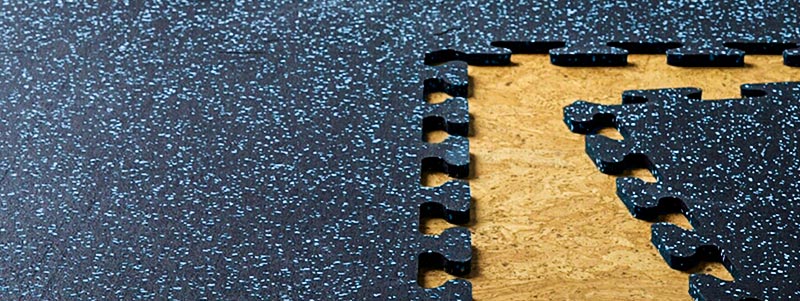
Interlocking Flooring Tiles are precise-cut interlocking pieces that install quickly with virtually invisible seams.
Rubber Interlocking Tiles for Gym Flooring
Interlocking or Puzzle Tiles are interlocking, durable and economical. They are available in corner, center, and border pieces.
Benefits of Interlocking Tile Rubber Flooring
- Precise interlocking tiles
- Easy installation
- Ultra-durable
- Made with reclaimed rubber materials
- 100% recycled rubber
- Nearly maintenance-free
- 5-year warranty
Commercial Gym Usage
Many commercial gyms and franchises rely on interlocking tiles for their facility’s rubber flooring. In some situations, a combination of rolled rubber and interlocking tiles is great for outfitting different sections of a gym while keeping in line with your budget. Interlocking Tiles are manufactured using the same high quality materials and color granules as our rolled rubber flooring, making it easy to mix and match while maintaining a consistent look.
Home Gym Flooring
Beyond commercial settings, interlocking tiles are also perfect for the home gym. They are low cost, lightweight, and easy to install. Several home gyms function as another room in the home; interlocking tiles are great for playrooms, as they are waterproof and easy to maintain.
Installation
Interlocking rubber tiles don’t need any adhesive—they click together, so you can install by just laying it down and connecting pieces. This can be done over almost any subfloor or finished floor without permanently installing them. Interlocking Tiles interlock so precisely that the seams are virtually invisible, so even though you don’t need adhesive, your tiles will stay put until you’re ready to remove or move them to another area.
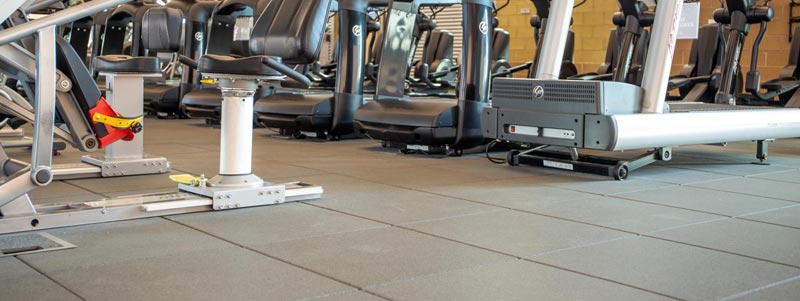
Peformance UltraTiles are super durable and offer the best shock & sound absorption
Performance UltraTile Rubber Gym Flooring
Performance UltraTile Rubber Flooring offers the best sound dampening and shock absorption properties for all fitness surfaces. As the heftiest rubber flooring option at a full inch thick, these beefy modular tiles withstand the most intense abuse and are perfect for heavy weight-training areas.
Benefits of Performance UltraTile Rubber Flooring
- Will withstand repeated heavy weight impact
- Thickest rubber flooring option
- Made with reclaimed rubber materials
- Long life expectancy
- Standardized tile allows ease of installation
- Quick and easy to install with Quad Blok installation system
- 10-Year limited warranty
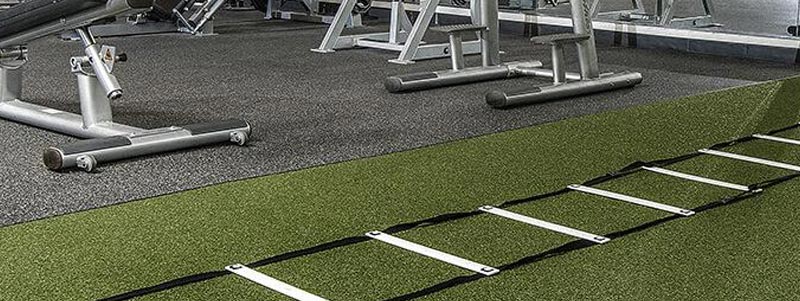
Compliment rubber flooring with turf—a popular flooring solution for functional fitness training
BONUS: Turf Gym Flooring
Made with reclaimed rubber materials, turf is another flooring surface that gyms of all types are using for functional training areas and performance athletic training. Turf features a dense, textured polyethylene surface layer, making it ideal for footwork drills and sled work.Turf can easily be integrated into your facility and alongside any rubber flooring style.
Gyms are becoming more diverse – they’re moving away from only containing standard cardio machines, stairmasters, and weights. As the demand for functional training increases, fitness clubs are creating spaces specifically designated for these workouts. Artificial turf flooring is no longer regulated to the football field, and more and more members look for the addition of turf in the gym they choose to workout in.
Frequently Asked Questions
What rubber flooring thickness is used in most gyms?
The thickness of your rubber flooring depends on what type of fitness center you have. Industry-standard is 3/8” (8mm) thick or 5/16” thick material. ¼” material is too thin to sustain protection against constant foot traffic and dropped weights. It's best used for areas with light traffic, in studios where weights aren't being dropped on it, or in a cardio area where light floor covering is needed.
A 3/8”+ thickness is recommended for underneath cardio equipment and under some strength equipment. 3/8"+ thick mats will absorb shock from lightweight dumbbells, barbells, and kettlebells.

Choose from a selection of standard, best selling colors
What colors are available?
Rubber flooring is available in a wide variety of best selling colors. With over 20 colors to choose from, you’ll be certain to find the right color for your fitness facility.
Custom Branding & Graphics
So you’ve got your color selected, but did you know you could also add your facility logo to your flooring? Custom branding is a great way to make your rubber flooring go the extra mile, whether you add a logo, inspirational message, or any other graphic.
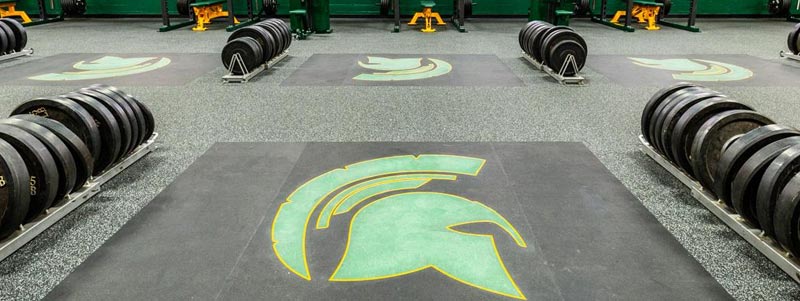
Installation doesn't have to be a headache. Read below for rubber flooring installation guides.
How do I install gym rubber flooring?
Rubber flooring is easy to install, but not a solo-project. There’s no reason to be a hero here – grab a buddy to help you out.
First things first—assess your subfloor. Rubber Flooring should be installed over concrete or wood (do not install over particleboard, chipboard, Masonite and lauan), and you need to make sure any old adhesives, roughness, defects, or irregularities are taken care of. Think of it like painting. Before you start, you have to prep.
Installing Rolled Rubber Flooring
You’re going to want to give yourself plenty of time to get this installed. Unroll all rolls and allow to relax overnight. A bare minimum of two hours is required for the rolls to rest. Lay the rolls down in a way that will use your cuts efficiently (it’s best to have this planned way before it’s go-time). Cut all rolls at the required length (if needed), including enough to run up the wall.
Place the edge of the first roll along your chalk line, and unroll. Continue rolling out the rest of the room and allow the rubber flooring rolls to acclimate to the room.
Make sure the rolls are tightly butted up next to each other and check to make sure they are straight and without any wrinkles or folds.
Installing Interlocking Tile Rubber Flooring
Interlocking Tiles are designed for easy installation so that a team of 2 or even just one person can tackle the install. Subfloor requirements are wood, laminate, concrete, existing resilient flooring, or very low pile commercial carpet.
Installation typically begins from the center of the room or area and then works its way out toward the walls. Take some accurate measurements, divide the area into 4 equal quadrants with a chalk line, and begin installing from the center. Interlocking or Puzzle Tiles interlock easily by gently tapping the tabs together (pro tip: use a rubber mallet to speed up installation vs. pressing them in by hand).
Installing Performance UltraTile Flooring
When it comes to installing Performance UltraTile Rubber Flooring, the process is similar to dropping in Interlocking Tiles, but you’re using adhesive. Performance UltraTile, like other rubber flooring, can be installed over most concrete, wood, and tile.
Determine your installation starting point by taking a look at the area you want covered. Is it wall-to-wall? Is it an irregular shape? The best starting point is often at the center—this ensures a symmetrical finish for tiles that may need to be trimmed around the perimeter. Installation is done by measuring and using a chalk line to set guidelines to install to.

Zogics Rubber Sport Flooring Cleaner & Degreaser – the best way to clean and maintain rubber flooring.
How do I clean my rubber gym flooring?
Your gym flooring is a big investment in your facility. Maintenance is easy with the right products and protocol, and imperative if you want your investment to last. Rubber flooring should be dry dust-mopped a couple of times a day; the more traffic you have, the more you should be sweeping, as dust and dirt will build up quickly.
Daily Cleaning
For daily cleaning, use a pH neutral cleaner/degreaser to apply to your flooring, let it sit for 5–7 minutes, then mop it up and rinse with clean water. Easy right? We’ve developed a cleaner specifically to maintain rubber sport flooring that will not only clean, but protect your flooring from unwanted wear patterns.
Weekly Deep Cleaning
Once a week, your rubber flooring should undergo a complete cleaning, so pull out those auto scrubbers! Using the same rubber floor cleaning solution, an autoscrubber will provide a deeper cleaning that picks up anything that you may have missed during your daily mopping.
You should allow the floor to dry thoroughly before introducing foot traffic, so try not to do a scrub down right before a class. Make sure you use the recommended cleaning products for your flooring type to preserve its finish.
Get more information on how to clean rubber flooring now. We put together everything you need, from products to process.
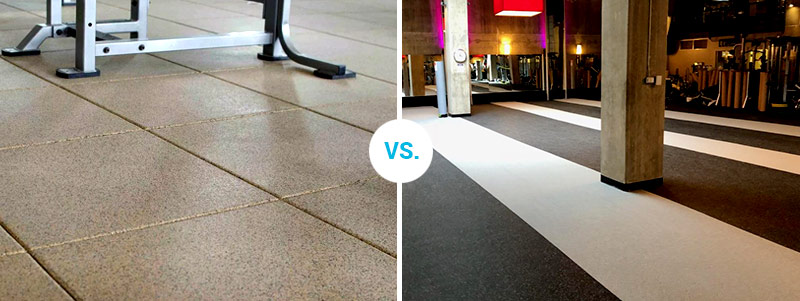
Know the differences between rolled and tile rubber flooring to make the best decisions on installation.
What is the difference between rubber tile flooring and rubber roll flooring?
How do you decide between rubber tile flooring and rubber roll flooring? While the benefits are nearly identical, and both work for either commercial or home gyms, there are some factors that may weigh into your decision.
Where are you installing flooring?
To start, where are you installing flooring? Is it a large commercial gym with a huge footprint? Are you laying down some rubber flooring in your garage gym? While Interlocking Tiles are easy to install, covering a large area with them could be a bit time consuming and may not be the most efficient solution. Interlocking flooring tiles are best suited for smaller rooms in a commercial gym, or for your home gym.
Rubber puzzle tiles also work in a commercial facility where you are leasing a building and may want to remove the flooring if you relocate. If you’re looking to cover a large portion of flooring, we recommend rolled rubber flooring.
When to use rolled rubber flooring
Rolled rubber flooring is a standard in most commercial gym settings and works perfectly for installing large sections. Rolled rubber is available in wider variety of thicknesses, which also helps facility managers determine which type is needed by room. Custom cutting also is a great benefit, because we know “one-size-fits-all” doesn’t always apply. Combine all of that with a bigger selection of colorways and you can see how rolled rubber flooring is the most ideal solution for a mid to large sized facility.
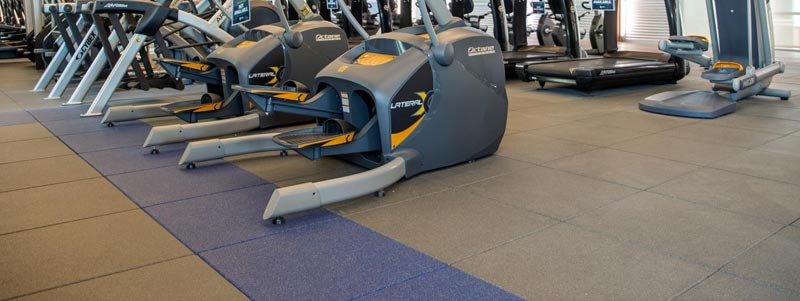
1" Tiles are perfect for weightlifting platforms and strength training areas due to its thickness
When to use rubber tile flooring
When it comes to Performance UltraTile Flooring, keep in mind this is the thickest option, and thus the most costly. But, certain areas of your gym (or whole facilities specialized in strength training) demand a thicker flooring option. Deadlifting platforms, strength training areas, and sections of your gym that take the most shock and abuse require Performance UltraTile Flooring. Like Interlocking Tiles, you can cover large areas with Performance UltraTile Flooring easily—but it might not be the most efficient use of budget. Additionally, is your facility on the second floor? The tenants below you may not appreciate dropped bars and plates all day. Performance UltraTile Flooring is the most sound absorbing flooring type.
Overall, take a look at your facility and assess its size and traffic. Take a look at how big your cardioarea is, where your weightlifting platforms are, and what other types of training spaces you have. The best option may be a combination of a few flooring types, but don’t worry—our flooring experts are here to take that assessment off your plate. After working with thousands of facilities, gyms, clubs, and home gyms, we’re here to provide you with a partner in your flooring project that walks you through the entire process, making recommendations all along the way. That’s a lot you’re missing out on by just ordering some tiles online or at your local hardware store.
Where is your rubber flooring made?
Unlike many competitors, who obtain unregulated flooring overseas, Ecore flooring is manufactured in the USA. While we don’t have to run through the long list of benefits of domestically-made products, the important things to remember are quality and efficiency—Ecore rubber flooring is undeniably the most premium quality product, from raw materials to the production process. Simply put, foreign manufactured flooring can’t compete.

Rubber flooring isn't just made for commercial settings. Bring high quality flooring to your home gym.
How thick should home gym flooring be?
You’ve made the decision to set up a home gym; the problem is, you don’t actually know how to set up a home gym. Sure, you can figure out what type of equipment to buy. But did you pause to consider the type of flooring you need?
DO NOT just repurpose some old carpeting or rugs you have in your basement. Your flooring protects both your equipment AND your body. It’s one of the most important steps in setting up a home gym, and one of the most often overlooked.
Rubber flooring is the best, safest, most affordable option for home gym flooring. The ideal thickness of gym flooring is 3/8″ (or 8mm). That’s thick enough to provide all the safety features you’ll need. It will safely support your squat rack, treadmill, rower, and other heavy machines. It will prevent these big items from moving and shifting around as you use them.
Interlocking Tiles are a great solution for home gyms, as they’re arguably the easiest to install and can be moved around if needed. Home gyms also don’t usually cover nearly the amount of square footage that a large or even mid-sized commercial gym requires. But don’t be fooled by cheap alternatives or a simple trip to the hardware store for generic rubber tiles. Quality means everything, and settling for anything less means a higher risk of injury and more times you’ll need to replace damaged flooring. What may seem cheaper in the beginning will cost way more when you’re on your fourth or fifth replacement.
What are VOCs?
Volatile Organic Compounds (VOCs) are a large group of chemicals that are found in many products in our environment. These chemicals “off-gas” into the indoor air we breathe, though you may not always be able to smell them.
But, simply put in the context of your rubber flooring, VOCs = “that rubber smell”—and who likes that? Guests and managers alike will agree that they’d prefer not to workout in a gym that smells like a tire. We pride ourselves in offering rubber flooring with extremely low VOCs compared to competing brands.
Additionally, we continue to service your flooring by offering eco-friendly cleaning solutions that are also manufactured with intentionally low VOCs. Zogics’ commercial cleaning supplies are concentrated to yield gallons of usable cleaning solution, all while promoting environmentally-responsible application. Our lineup is ECOLOGO approved and offers the diversity needed to meet a wide range of uses and specialities.
What flooring do commercial gym use?
When it comes to commercial gym flooring, rubber, vinyl, and turf are the most popular flooring options for gyms. Rubber is the most common because it's relatively affordable, durable, easy to clean, and versatile as it comes in both tiles and rolled. Vinyl can give you the durability you need in the gym with a wood-grain look, and turf is perfect for function fitness training.
How much does gym flooring cost?
Rubber rolls cost anywhere from $2.50 to $8.00 per square foot, with the most popular products falling in the $2.50-$4.00 range per square foot.
For professional installation, expect the product-and-labor costs to run between $2.50 and $5.00 per square foot, depending on the product and the provider, and the size of the space.
Is rubber gym flooring safe?
Yes, today’s rubber gym flooring is totally safe. Modern rubber flooring does not emit mercury or any toxins. Keep in mind though that if you have synthetic rubber flooring in your gym from the 1960s-1980s, it’s a good idea to have it tested by an expert for mercury. After the 1980s, mercury-containing rubber was discontinued, yet many of these rubber floors stayed in gyms for years to come. If the tests come back positive, you may need to partner with a specialized cleanup crew to dispose of the material.
What is the best flooring for a gym?
The best flooring for a commercial gym really depends on the use-case for members. You’ll find rubber flooring in most facilities due to its durability, shock absorption and sound-reducing performance. Turf flooring is used in many gyms as well, especially for certain training exercises like sled pushes and HIIT workouts. It provides soft cushioning and firm support. Synthetic turf is also known to absorb energy during a fall as well as reduce stress on the joints.
How long does rubber floor last?
Rubber floors and mats will last for decades – up to 30 years – making them extremely cost effective.
What do you put under gym flooring?
Commercial gym floors should always have an underlay underneath the rubber flooring to prevent damage.The risk of not using an underlay is a weight breaking a board (if installed directly on top of plywood) or cracking the concrete underneath the rubber flooring. It’s also important to consider how underlay makes a floor feel when lifting or working out. The floor feels more solid and more forgiving, creating a better surface for people to perform a workout with confidence.
Let's Get Started!
Reach out to our flooring experts or fill out a quick form for a quick quote. We're here to help with product selection, design & layout, quoting, and maintenance. Whether it’s a brand new build-out or an upgrade to an existing space, we have the flooring solution for your facility.



